Rosemary is grown for its fragrance and flavour in equal measure but despite coming from a relatively similar climate to our own it tends to struggle in Australia, particularly through winter.
In this guide, you’ll discover how to grow Rosemary, how to keep rosemary alive, and some of the more unusual uses for this undersung kitchen hero.
We particularly want to dispel the myth that rosemary is difficult to grow, and instead, focus on some of the common mistakes that Australian gardeners make when growing this Mediterranean shrub.
More...
What is Rosemary?

Rosemary is actually a very particular species of Salvia, the fragrant, low-growing shrubs we grow in our gardens all over Australia. While Salvia are typically grown for their fragrance, rosemary is more often grown for its flavour, packed with rich, earthy essential oils that not only taste good but have been shown to improve our memory and mental focus.
Like many plants with abundant essential oils, rosemary also has powerful stress-relieving properties. These are down to nostalgia and conditioning as much as any chemical reaction, as rosemary is the traditional flavour of a Sunday roast.
Rosemary’s Natural Habitat
Rosemary, or Salvia rosmarinus, is a Mediterranean shrub that thrives in loose, free-draining soils. This herb needs very little care once established but should be pruned annually to help retain a good shape.
While the Mediterranean is geographically limited to the warm dry climates of Libya, Greece and Italy, in horticultural terms Mediterranean plants are plants that grow in those conditions and can be found growing native in Australia, South America and along the east coast of Africa.
This plant might not grow naturally in Australia but it’s important to understand that our climate is, for the most part, perfect for these low growing Mediterranean shrubs.
Rosemary Varieties to Grow in Australia
1. Salvia rosmarinus ‘Prostratus’ (Trailing rosemary)

Source: garden.org
Salvia rosmarinus ‘Prostratus’ is an amazing ground cover plant, which works well in hanging baskets, or window boxes where other plants can suffer from the extreme drought that these well-drained conditions are known for.
The low growing form of rosemary is a naturally occurring species and has many sub-species and cultivars sold throughout Australia, but most will reach a spread of around 1-1.5m after five years, and rarely grow taller than 30cm.
2. Salvia rosmarinus ‘Benenden Blue’ (Rosmarinus angustifolia)

Source: shop.garten-jan.de
Angustifolia are bushy, evergreen rosemary within the upright group. Their dark green leaves are tipped with masses of pale blue flowers in spring and early summer, but the most intriguing rosemary ‘Benenden Blue’ can flower twice every year.
Benenden Blue often flowers a second time in autumn if the days are long enough and it’s given enough sun. To encourage re-flowering, cut the plant back a few inches after flowering in spring.


Get Your Free Guide:
Master Growing Australian Natives eBook
A Must Have Complete Guide for Every Australian Garden
Get Your Free Guide:
Master Growing Australian Natives eBook
A Must Have Complete Guide for Every Australian Garden
3. Salvia rosmarinus ‘Miss Jessopp’s Upright’
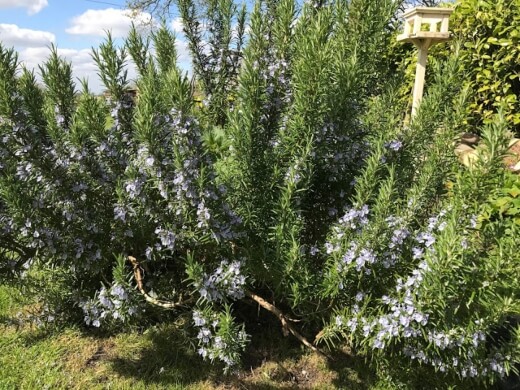
Source: thinkingofthedays.blogspot.com
Salvia rosmarinus ‘Miss Jessopp’s Upright’ is a good rosemary for containers thanks to its slow-growing, compact form. Rosemary ‘Miss Jessopp’s Upright’ responds well to root pruning too, so can stay in the same container for its entire lifetime, producing rich, flavourful foliage for at least ten years before its flavour begins to fade.
Even once the flavour has faded in Miss Jessopp’s blue, they make beautiful garden plants that continue flowering for many years.
4. Salvia rosmarinus ‘Lady in White’

Source: designerplants.org
A rare white flowering rosemary, Salvia rosmarinus ‘Lady in White’ is a graceful option for gardeners waiting for a stricter colour palette but is also great for evening wildlife as the white flowers of this upright rosemary are bright late into the evening providing an excellent food source for evening birds and moths.
How to Grow Rosemary in Australia
Rosemary will grow in surprisingly cool conditions but does need at least six hours of sun per day to produce those gorgeous essential oils. The key to success with Salvia rosmarinus is providing a clear and well-drained root run, so their roots are never compacted.
For most growers, that means that the best place to plant rosemary is in the ground, and while we might be used to planting rosemary in containers as patio features plants, they will almost certainly need regular repotting.

Drainage & Soil to Use
If you have clay soil, you should add plenty of grit and compost to the planting hole so that water can drain away. Add grit or gravel to the base of the hole too so there is a layer of pure drainage underneath rosemary plants.
When you prepare the site for rosemary, dig a hole that is at least twice as big as the root ball. Salvia rosmarinus is very susceptible to root compaction, so creating space for roots to grow outwards allows them to search for nutrients, and prevents them from growing around in a circle.
In terms of compost mixes, most Australian soil will be suitable for this plant as it is, but if you want to add nutrients and moisture retention, mix a few generous handfuls of compost with garden soil before filling back in around your plants. (Find out how to make composting easier here.)
Light Requirements
Rosemary loves the sun. These Mediterranean plants have evolved to produce even more essential oils in higher temperatures as their oils keep pests away and protect them from rabbits, deer and other grazing mammals that might otherwise eat them.
Find a bright, sunny spot in the garden that gets at least 6 hours of full sun per day in summer.
Watering Rosemary
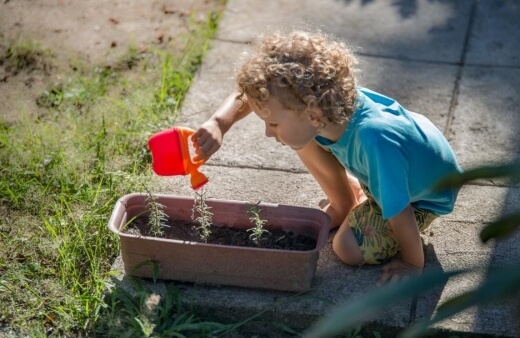
Once planted, water rosemary once a week for at least a month in the spring and summer of the first year. After the first year, you should never need to water rosemary.
They are incredibly drought-tolerant plants, so unless you see rosemary leaves turning brown as crisp, there is very little need to water Salvia rosmarinus in the garden after they have been established.
Growing Rosemary in Pots
It is always best to grow rosemary, of all types, directly in the ground, but if you are gardening for visuals, and for scent, growing this herb at a higher level means you are more likely to benefit from its aroma on the patio as you brush past it, or even sit next to it.
The problem with growing this herb in containers is that it's roots are easily overcrowded, so you will need a very free-draining compost, with some consideration for moisture retention, either through stones, or water-retaining gel crystals, or good old fashioned regular watering.
Use a terracotta pot as the colour of the terracotta gives you a good guide for when to water, and won’t allow water to saturate the soil. Add plenty of rocks to the base of your container so that the roots are never allowed to sit in moisture, and use a container that is about 2” bigger than the root ball of the rosemary you are planting.
Using a slightly larger container ensures roots have space to grow, but not so much space that compost becomes saturated.
Keep your containers in full sun, and add gravel or grit to the surface of the container. This helps keep moisture in, allows water to drain, and reduces competition for weeds (and it looks good).
Propagating Rosemary
Rosemary grows well from almost all forms of propagation but the two simplest ways to create new plants are to grow them from seed and take rosemary cuttings. We’ve got guides to both forms of propagation below:
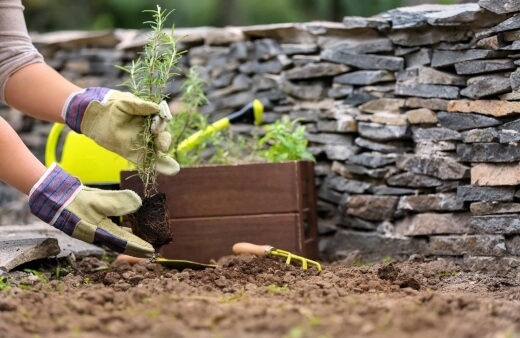
Rosemary Propagation from Seed
Growing this herb from seed is significantly slower than growing rosemary from cuttings, but it is a very reliable way of producing a lot of plants on a budget. There are thing important factors to germination:
- Heat
- Light
- Drainage
Rosemary seeds should never be left in damp compost, but do benefit from humidity, so a good quality heated propagator is important to reliable germination, ideally placed on a sunny windowsill.
To grow from seed, you will need:
- 1 seed tray
- 1 heated propagator
- Seed compost
- Grit
Method:
- Prepare your rosemary seeds for planting by soaking them in warm water for 4-8 hours (overnight is fine).
- Prepare a compost mix by filling a seed tray with a 50:50 mix of horticultural grit and compost.
- Level the compost mix in the seed tray leaving a 5mm gap between the surface of the soil and the lip of the tray.
- Thinly sow seeds across the surface (roughly 2cm apart).
- Place the tray in water so it can soak moisture up from the base. This draws seeds down into contact with the soil and provides even saturation.
- Place the seed tray in a covered heated propagator, then leave for up to eight weeks.
- Keep the soil moist but not saturated until the first signs of germination.
- After germination, keep rosemary seedlings moist by misting them in their propagator until true leaves appear.
- When you have true leaves, gently prick out seedlings and add them to individual pots with the same compost mix as before.

Propagating from Cuttings
If you already have a rosemary bush then taking your own cuttings could not be easier. You can take cuttings any time from late winter to late autumn provided there is reasonable fresh growth and signs of new leaves to come.
The other benefit of rosemary cuttings is that by taking them in spring when you should ideally cut rosemary bushes back slightly anyway, you have loads of cutting material available without even knowing!
Tools:
- Small plastic pots
- Cutting compost mix
- Pencil / Pen / Dibber
- Clear plastic bags or old plastic bottles
Method:
- Prepare your cutting containers, which in the case of rosemary should have plenty of humidity.
- Fill small plastic pots with a cutting compost mix
- Cut used plastic bottles in half
- Place the pot in the bottom part of the bottle
- Push the top half of the bottle over the top
- Your very own mini greenhouse!
- Fill small plastic pots with cutting compost
- Dib a small hole in the compost, ideally against the edge of the container
- Cut the growing tips of your plants so you have 3-4” sections of the stem, with leaves at the top.
- Strip off all but a small cluster of leaves at the tip, leaving a bare stem.
- Push the stem into the hole in the compost, and water well. Watering will push soil into the hole and provide perfect contact so there is no need to push the soil around the cutting, this will just compact it.
- Place in your mini-bottle greenhouse, or cover with a plastic bag, then leave until new growth appears.
- Water if the soil is looking dry
For cuttings taken in late autumn, leave them in a humid space over winter, and new growth should start in early spring. For cuttings taken in spring or summer, new growth should happen after about 1 month.
Caring for Rosemary
Mulching
This aren’t thirsty plants but are used to cooler winters than we have in Australia, so benefit from a mulch over winter to prevent them from drying out during dormancy.
There is no need to fertilise rosemary in Australia unless they are grown in containers. To give your plant a boost, use garden compost or leaf mould as a mulch in spring.
See our complete guide on the best types of mulches you can use in your garden.
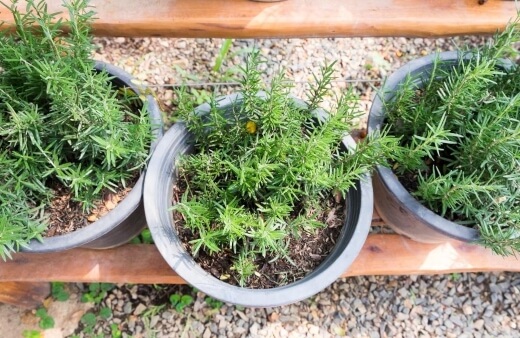
Pruning Rosemary
This herb needs pruning annually to retain a good shape. After a few years, you’ll notice rosemary forming hollow patches in its centre and it is very difficult to bring its shape back to something fuller when that happens.
To help retain a neat mound, cut back by 2-3” every year using standard hedge pruning shears. You can be very rough when pruning, and often more, is more.
Just check back at the plant, but don’t go right back to old wood, as it will bush out better if you just cut back to green leaves.
Repotting
Rosemary in containers needs repotting once every three years as a minimum. For small gardeners, you can root prune rosemary to help keep it in smaller containers, but should also cut back the top growth at the same time to reduce strain on these plants.
To root prune, simply shake off the old roots, remove any dead, damaged or diseased roots, and use shears or scissors to remove around 1” of roots.
Once you’ve cut the roots back slightly, repot with fresh compost around the edges and water well. Finish up by cutting back the top growth by 1-2” to reduce strain on the roots while they re-establish.
Rosemary Pests and Diseases
Rosemary are tough plants which almost never suffer from pest damage. Their powerful essential oils are incredibly off-putting to aphids, whitefly, blackfly, mealybugs and mites so if you see any of them gathering on your plant, the best way to stop it is to stop watering.
They are often there because over-watering causes weakness, and reduces the potency of essential oils, making the spas more palatable.
Froghopper or Spittlebug
One pest to look out for, and we really do mean this, is the froghopper, or spittlebug. They are not currently present in Australia but spread a disease called Xylella, which, if found in Australia, should be reported to authorities as it is a destructive plant which could cause widespread damage to native wildlife.
Sadly, Xylella has spread throughout Europe, Asia and Africa due to plant importation throughout the 1900s. If you spot spittlebugs (small translucent insects covered in mounds of foamy mucus), report it to local authorities.
As with pests, there are very few diseases that this plant suffer from in Australia. If your plants look dry, check their roots. If they are damp, but the tops look dry, remove them from the soil, shake off any soil and cut back damaged roots.
This is usually caused by root rot as a result of badly draining soil. Improve drainage and pop your plant back into the ground.
If, more simply, the tops look dry, and the ground is dry, your plant is just thirsty. Water well, and repeat over the next couple of days when the soil is dry.
Rosemary FAQs

Are coffee grounds good for rosemary?
This herb enjoys an occasional nitrogen feed, and coffee grounds are a useful alternative to shop-bought fertilisers, providing balanced slow-release nitrogen to the soil.
Coffee grounds also add magnesium and potassium to the soil which isn’t particularly useful to this herb but does help improve overall soil health.
Can rosemary have too much sun?
This herb can’t have too much sun. Their preferred position is somewhere with a round six hours of full, direct sunlight every day, but 8-12 hours of direct light in summer is manageable for these drought-tolerant, sun-loving plants.
Should you let rosemary flower?
Not only are it's flowers beautiful, but they are also incredible for wildlife, and safe to eat. Rosemary flowers taste just like the foliage, but with sweet nectar at their base which makes them incredible in salads.
Don’t remove all of your flowers though, leave at least 50% on the plant for pollinators.
Is rosemary toxic to pets?
This plant isn’t toxic in any form, but you should never ingest rosemary essential oil as the potency of the oil in its pure form is too much for most stomachs and will cause severe stomach upsets.
Looking to grow more plants in your garden? How about growing not only an edible one but also prehistoric? See our Amaranthus growing guide to know more about this fascinating plant.
For tips on expanding your rosemary garden, watch our YouTube video:
Propagating Rosemary Using Two Simple Methods
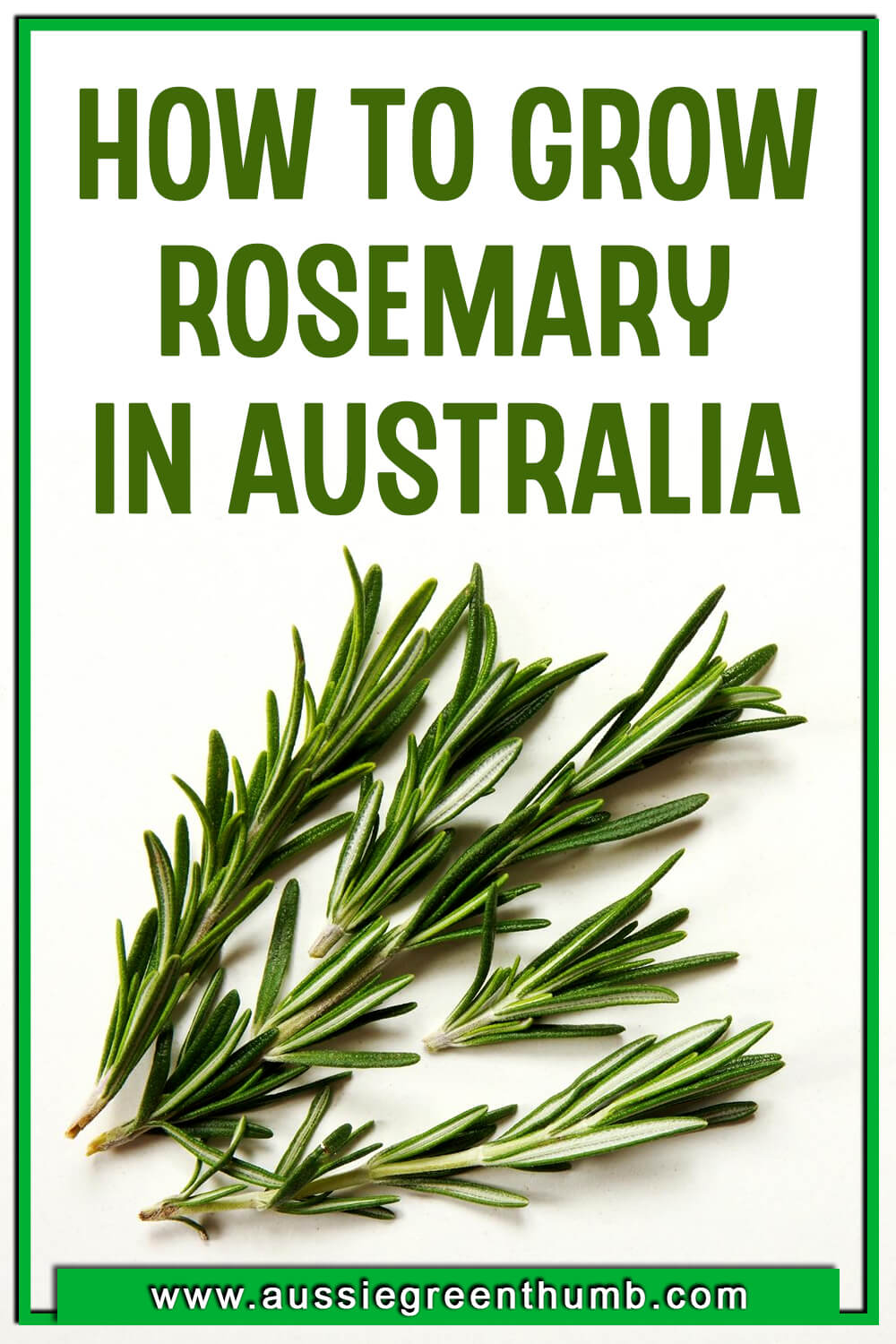
Wrapping Up Our Growing Rosemary in Australia Guide
If you’re looking for a low maintenance place that brings buckets of fragrance and structure to a garden without the risk of blights, droughts and mildews, then rosemary is the perfect plant for you.
Growing Salvia rosmarinus in Australia could be easier. Despite the fact that this herb isn’t native to our island nation, its native environment is almost identical. Just provide rosemary with good drainage, and cut back like any shrubby hedging plant once a year.
Published on May 24, 2022 by Maisie Blevins
Last Updated on September 26, 2024




